NASCAR In May: History Is Beautiful This Time Of Year

Historic Darlington Raceway is a special race track for NASCAR and for area resident and guest columnist Cathy Elliott.
Guest Column By Cathy Elliott
It’s race week in Darlington, and I am sitting in my office -- also in Darlington. I am surrounded by flyers and posters and cardboard stand-ups of various drivers smiling hopeful smiles, most of which will be replaced by scowls and a few choice words once the green flag drops at the cantankerous old track.
I’m thinking about what happened last year and 10 years ago, and what might happen next week, when that familiar wave of nostalgia hits me. For those who are fans of NASCAR’s grand and slightly checkered past as well as its glamorous present, there is simply no better time of year than the month of May.
The NASCAR Sprint Cup Series events run in May offer some of the best racing of the season at three of the sport’s finest – and oldest – tracks.
These include, in addition to Darlington Raceway, Richmond International Raceway, whose furious short track action generally fans a few flames and whips up some sort of a grudge match headed into Darlington, and Charlotte Motor Speedway, home of both the NASCAR Sprint All-Star Race and the annual NASCAR marathon also known as the Coca-Cola 600.
These places can only be described as legacy tracks. Darlington’s first race was held in 1950, and Richmond was hot on its heels, opening the gates in 1953. Charlotte is the baby of this family; they didn’t start superspeedway racing until 1960.
Just to add a little icing on the cake, the NASCAR Hall of Fame will officially celebrate its grand opening this month, as well.
Seriously, May is so richly grounded in racing tradition it’s like one of those chocolate truffles that are so sweet they actually hurt your teeth. It almost makes you want to give the other months a hug, just to make them feel better about themselves.
Cruising through the garage on race weekend at some of these older tracks makes you feel like an extra in the movie Back to the Future. On any given day you might see David Pearson eating a sandwich while explaining the vagaries of Darlington’s Turn 2 to a rookie driver, Bud Moore leaning up against a stack of Goodyears in Charlotte, or Richard Petty pretty much anywhere, ambling around and just being nice to people, because that’s how he rolls.
Not too many years ago, you stood a pretty decent chance of bumping into another guy, checking things out with a sharp eye while chomping on a hot dog, which was his favorite food. Media-friendly drivers aside, the late Bill France, Jr. is probably stock car racing’s most recognizable face.
The new book titled Bill France Jr.: The Man Who Made NASCAR, couldn’t have been released at a more appropriate time. As the races this month chronicle the expansion of NASCAR’s early years, the book chronicles the hand that primarily guided its growth for more than three decades.
As author H.A. Branham has structured the story, France’s life and career mirrors the evolution of the sport with which his family’s name is synonymous.
For example, France spent his early days selling snow cones at the track and yanking people off fences who were trying to watch the races for free.
Later, he brokered the groundbreaking sponsorship deal with RJR that would brand the entire Cup Series with the company’s top product name. Back then, the sheer scope of such an idea was basically untried and unheard of. Branham describes it as “a match between an outlaw sport and an outlaw product.”
During those first couple of decades of racing at these tracks we now consider the cornerstones of the sport, NASCAR really was a snow cone-eating, fence-yanking kind of animal – a renegade. But thanks in large part to that outlandish sponsorship idea, a trail was blazed for companies like current series sponsor Sprint to move in with innovative technology that provides the perfect vehicle for the contemporary face of stock car racing. Sadly, France is gone, but his son Brian stepped into those ambitious shoes, and kept right on walking.
And the beat goes on. Sponsors will inevitably come and go, and NASCAR will continue to identify its boundaries, and then expand them.
The cool thing is that while moving ahead just as far and fast as it can go, the heart of NASCAR will still find a way to remain grounded in its past. If history came alive in the classroom like it does at Darlington, Richmond and Charlotte, we would all have been much better students way back when.
Thank goodness – and thank NASCAR – these old teachers are still on the job. Just ask the drivers still pursuing those elusive A+ trophy grades – they still have something left to teach us.
